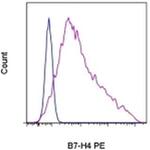Search Thermo Fisher Scientific
Invitrogen
B7-H4 Monoclonal Antibody (H74), PE, eBioscience™
FIGURE: 1 / 1
B7-H4 Antibody (12-5949-42) in Flow

Product Details
12-5949-42
Species Reactivity
Published species
Host/Isotype
Recommended Isotype Control
Class
Type
Clone
Conjugate
Excitation/Emission Max
Form
Concentration
Purification
Storage buffer
Contains
Storage conditions
Shipping conditions
RRID
Product Specific Information
Description: The H74 monoclonal antibody was generated and reacts with human B7-S1, also known as B7-H4 and B7x. Cross reactivity of this antibody to other proteins has not been determined. B7S1 is a newly discovered member of the B7 family. It is speculated that the costimulatory regulation of T cells by B7S1 is influenced by the activation status of B cells. While it is reported that BTLA is a counter receptor for B7S1, further studies are needed to definitely determine the B7-H4 ligand. H74 stains human B7-H4 transfected cells and not peripheral blood cells. Exact expression pattern of B7-H4 has not been fully characterized.
Applications Reported: This H74 antibody has been reported for use in flow cytometric analysis.
Applications Tested: This H74 antibody has been pre-titrated and tested by flow cytometric analysis of human B7-H4-transfected cells. This can be used at 5 µL (0.125 µg) per test. A test is defined as the amount (µg) of antibody that will stain a cell sample in a final volume of 100 µL. Cell number should be determined empirically but can range from 10^5 to 10^8 cells/test.
Excitation: 488-561 nm; Emission: 578 nm; Laser: Blue Laser, Green Laser, Yellow-Green Laser.
Filtration: 0.2 µm post-manufacturing filtered.
Target Information
B7-H4 (B7x, VTCN1) a costimulatory protein which is reported to function as a negative regulator of T-cell mediated immunity. Although B7-H4 binds an unknown receptor, it is thought to deliver an inhibitory signal to T-cells preventing their proliferation, cell cycle progression and interleukin-2 production. B7-H4 deficient mice are only minimally affected; suggesting B7-H4 is important in the fine tuning of the T-cell mediated immune response. B7-H4 is expressed on activated T-cells, B-cells, monocytes and dendritic cells. Aberrant expression has been associated with cancers of the lung, breast and ovary in humans. B7-H4 is expressed primarily on the membrane of lymphoid cells, and as an immunoinhibitory protein that interacts with receptors on the surface of T lymphocytes, it is involved in mediating cellular and humoral immune responses. Overexpression of B7-H4 is associated with certain malignancies, including ovarian and breast cancer, which may be a mechanism by which tumor cells suppress T cell immunity and facilitate tumor progression. Further, VTCN1 may be a useful biomarker for the early detection of ovarian cancer and Renal Cell Carcinoma (RCC).
For Research Use Only. Not for use in diagnostic procedures. Not for resale without express authorization.
How to use the Panel Builder
Watch the video to learn how to use the Invitrogen Flow Cytometry Panel Builder to build your next flow cytometry panel in 5 easy steps.
Bioinformatics
Protein Aliases: B7 family member, H4; B7 homolog 4; B7 superfamily member 1; B7-H4; B7h.5; FLJ22418; Immune costimulatory protein B7-H4; Protein B7S1; RP11-229A19.4; T cell costimulatory molecule B7x; T-cell costimulatory molecule B7x; V-set domain-containing T-cell activation inhibitor 1; VTCN1
Gene Aliases: B7-H4; B7h.5; B7H4; B7S1; B7X; PRO1291; UNQ659/PRO1291; VCTN1; VTCN1
UniProt ID: (Human) Q7Z7D3
Entrez Gene ID: (Human) 79679

Performance Guarantee
If an Invitrogen™ antibody doesn't perform as described on our website or datasheet,we'll replace the product at no cost to you, or provide you with a credit for a future purchase.*
Learn more
We're here to help
Get expert recommendations for common problems or connect directly with an on staff expert for technical assistance related to applications, equipment and general product use.
Contact tech support

